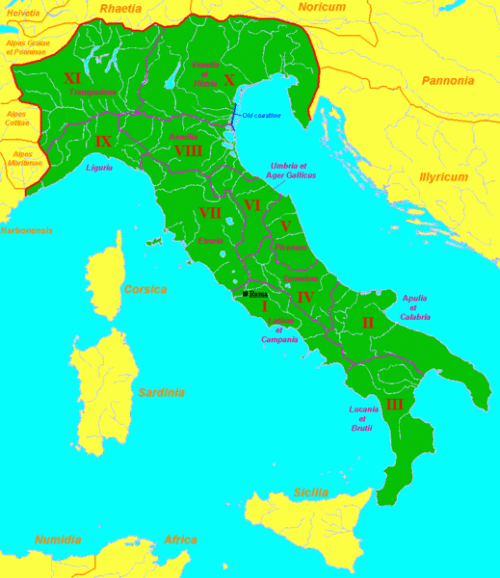The Italian lands were a cultural mosaic of many peoples, among which the Etruscans, Samnites, Greeks and later also the Latins were in the lead. Although the continual conquest of the peninsula (province) by Rome, in the middle of the third century BCE almost the entire province was Roman, the integration of individual peoples with the rulers of the Tiber ended only at the beginning of the 1st century BCE, when after the wars with the allies, all Italians (free, of course) received citizenship.
Italia in the 5th century BCE it meant only its southern part, and in III, all areas subordinate to Rome. During the time of Julius Caesar, the area stretched from the Strait of Messina to the Rubicon River. At that time, Pre-Alpine Gaul in the Po river valley and Liguria were not considered part of it. About 27 BCE during the reign of Augustus, Italy had already reached the foothills of the Alps. Throughout antiquity, Italy did not include Sicily, Sardinia and Corsica.
At the beginning of the establishment of the Roman Empire, Italy consisted of territories with different status. Some cities, such as municipii, had some independence from Rome. The colonies, in turn, were founded by the Romans themselves. The full organization of Italy ended in the 1st century BCE, around 7 BCE, when Emperor Octavian Augustus divided all of Italy into 11 regions(regiones) as Pliny the Elder describes in his Naturalis Historia (“Natural History”):
- REGION I: Lazio (Latium), including Rome, and Campania (Campania);
- REGION II: Apulia and Calabria;
- REGION III: Lukania i Brucjum (Lukania, Brutium);
- REGION IV: Samnium;
- REGION V: Picenum;
- REGION VI: Umbria and Ager Gallicus;
- REGION VII: Etruria;
- REGION VIII: Aemilia;
- REGION IX: Liguria;
- REGION X: Venetia and Histria;
- REGION XI: Transpadana.
The southern part of Italy along with the eastern part of Sicily in ancient times was often referred to as Magna Graecia (Great Greece) due to a large number of Greek colonies there.
Italy is flooded by the seas:
- Mare Tyrrhenum (Tyrrhenian Sea)
- Mare Adriaticum (Adriatic Sea)
- Mare Ionium (Ionian Sea)
Italy was a region favoured by Emperor Augustus and his successors. Most important public utility buildings were built there and a dense network of roads was developed.
The Italian economy flourished. Agriculture, crafts and industry developed, which made it possible to export goods to other provinces.
With the economy, the population of Italy grew. During the reign of Augustus, three censuses were carried out to determine the number of Roman citizens in the entire empire. According to a census from 28 BCE the number of Italian citizens was – 4,063,000; in 8 BCE – 4,233,000; and in 14 CE – 4,937,000. However, these numbers are still under discussion. It is not known whether these figures refer to all citizens, adult male citizens, or sui iuris citizens. The latter type of citizen was a person who was not subject to the power of pater familias. It is a category of people separated on the basis of the so-called status familiae, i.e. the position in an agnatic family and not related to the cognitive situation (the issues of having children or being married did not matter) or age (so an infant could be pater familias). sui iuris persons had full property capacity, ie they could be holders of property rights (have ownership or limited property rights). Returning, however, to the censuses, it is not known how many exactly citizens actually lived in Italy.
According to the estimates of modern researchers, the numbers were completely different. Karl Julius Beloch in 1886 decided that at the beginning of the 1st century CE mainland Italy, including Gallia Cisalpina, was around 6 million people. Russell in 1958 had 6.83 million, Hin in 2007, 10 million, and Lo Cascio in 2009, 14 million.
When in 212 CE Emperor Caracalla granted all inhabitants of the Empire Roman citizenship Italy lost its dominant and prestigious position among the rest of the provinces. In addition, Italy, at the end of the 3rd century CE, was constantly plagued by attacks by barbarian tribes.
During this time, Emperor Diocletian divided the Empire into four parts and several dioceses thus introducing tetrarchy. Diocesis Italiae, after the Augustus Western rule, was divided into two areas, which in turn were divided into smaller regions – the so-called correctores.
- Italia suburbicaria, with its capital in Rome:
- Tuscia and Umbria;
- Valeria;
- Campania and Samnium;
- Apulia and Calabria;
- Sicilia;
- Sardinia and Corsica
- Italia annonaria, with its capital in Mediolanum:
- Venetia and Histria
- Aemilia and Liguria
- Flaminia and Picenum
- Raetia
- Alpes Cottiae
The former Alpes Poenninae and Alpes Maritimae regions have become part of Diocesis Galliarum.
When the barbarians became the most important problem facing Rome, the emperors were forced to leave the capital, thus emphasizing the region’s decline. In 330 CE Constantine I moved the capital of the Empire to Constantinople, along with the imperial court, economic administration and military structures (e.g. the fleet of and Ravenna).
After the death of Emperor Theodosius in 395 CE, Italy became part of the Western Roman Empire. Then came the years of the barbarian invasions and the transfer of the capital of the ruler of the Western Empire from Mediolanum to Ravenna in 402 CE. In 410 CE Rome captured and sacked Alaric, chief of the Visigoths, a precedent for eight centuries. Northern Italy was attacked by Attila and the Huns in the years that followed; and to make matters worse, in 455 CE the leader of the Vandals, Geiseric once again conquered Rome.
According to Notitia Dignitatum, the Roman document of the civil service and command staff, which was to be completed in the 20 5th century CE. for information about the western part of the Empire, Italy was ruled by the prefect – Prefectus praetorio Italiae (he managed Gaul, Italy, Africa and Illyria), one vicarius and one comes rei militaris. The regions were governed by eight consulares (Venetiae et Histriae, Aemiliae, Liguriae, Flaminiae et Piceni annonarii, Tusciae et Umbriae, Piceni suburbicarii, Campaniae and Siciliae), two correctores (Apuliae et Calabriae and Lucaniae et Bruttiorum) and four praesides (Alpium Cottiarum, Samnii, Sardiniae Corsicae)
At that time, the “Western” rulers were controlled and under the influence of barbarian chiefs. This situation made it impossible for the imperial authority to control Italy, whose coasts were under constant attack. In 476 CE Romulus Augustulus resigned and returned the imperial insignia to Constantinople, thereby bringing down the Western Roman Empire. Then, for 77 years, Italy was under the influence of Odoacer, and later the Ostrogothic Kingdom.








